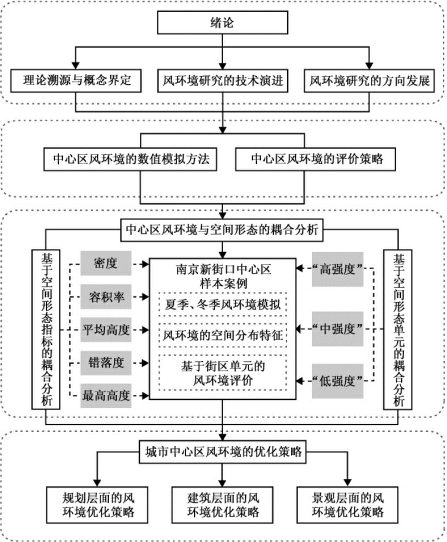
基于城市中心区风环境的数值模拟方法和评价策略,结合样本案例——南京新街口中心区,分析其夏季、冬季行人高度处风环境的空间分布特征,并对各街区单元的风环境进行评价。在此基础上构建城市中心区风环境与空间形态的耦合分析方法,从空间形态指标和空间形态单元两个角度分别进行耦合分析,分析与总结城市空间形态与城市风环境的关联性及其影响机制,进一步从规划、建筑和景观三个层面归纳城市中心区风环境的优化策略(图1-7)。全书共分为七个章节:

图1-7 研究技术路线
*资料来源:作者自绘
第1章绪论:剖析城市风环境研究的技术方法、研究的方向发展以及城市风环境基本概念和特征,明确研究对象的价值与意义。
第2章城市中心区风环境的模拟方法和评价策略:基于CFD软件风环境数值模拟的基本方法和流程,构建适用于大尺度的城市中心区风环境模拟的计算机数值模拟技术;基于现有的室外风环境评价的相关政策标准以及常用的室外风环境评价方法,构建适用于大尺度的城市中心区风环境的评价策略,其中总体层面的夏季行人高度处风环境的风速数值评价标准主要适用于夏季高湿热气候特征的城市地区,街区层面选取街区平均风速、舒适风速比率、风速的离散度、静风区面积比以及强风区面积比5项评价指标综合评价城市街区风环境的优劣。
第3章南京新街口中心区风环境的分布特征分析与评价:通过数值模拟与研究分析,充分了解和认识南京新街口中心区夏季、冬季行人高度处风环境的基本状况和特征。
第4章新街口中心区风环境与空间形态指标的耦合分析:探讨城市规划常用的空间形态指标与行人高度处风环境的关联性,通过耦合分析得出各项指标因子与行人高度处风速的影响关系,其中街区或用地的建筑密度和围合度与其行人高度处平均风速水平存在负相关的线性关系,平均高度与其行人高度处的平均风速水平存在正相关的线性关系,且三个指标因子的影响程度依次为:平均高度>建筑密度>围合度;错落度、最高高度与其行人高度处的平均风速水平相关联,但不是线性关系,容积率与其行人高度处的平均风速水平则无直接联系。
第5章新街口中心区风环境与空间形态单元的耦合分析:探讨不同类型的空间形态单元与行人高度处风环境的关联性,针对城市中心区内13类典型的空间形态单元,研究与分析其行人高度处风环境的特征、问题与成因,并提出部分针对性的风环境优化设计措施。
第6章城市中心区风环境的优化策略:基于本书研究和部分已有研究成果,从规划层面、建筑层面和景观层面三个方面总结城市中心区风环境的优化策略,以期为规划设计工作提供意向指引。
第7章规划设计中的风环境优化设计实践:结合若干不同尺度的规划设计案例,阐述在项目实践中针对不同研究对象的风环境优化策略的应用。
【注释】
[1]ASHRAE.ASHRAE Handbook of Fundamentals[M].Mar Lin Book Company,1974
[2]李文娟,等.霾污染及其对人体健康的影响[C]//第31届中国气象学会年会S11第三届城市气象论坛——城市与环境气象,2014
[3]任超,吴恩融.城市环境气候图——可持续城市规划辅助信息系统工具[M].北京:中国建筑工业出版社,2012
[4]Man Sing Wong,Janet Nichol,Edward Ng.A study of the“wall effect”caused by proliferation of high-rise buildings using GIS techniques[J].Landscape and Urban Planning,2011(102):245-253
[5]Wiren B G.A wind tunnel study ofwind velocities in passages between and through buildings[C]//Proceedings of the 4th International Conference on Wind Effects on Buildings and Structures,(Heathrow 1975),1975:465-475
[6]Stathopoulos T,Storms R.Wind environmental conditions in passages between buildings[J].Journal ofWind Engineering and Industrial Aerodynamics,1986,24(1):19-31
[7]Shuzo M,Yoshiteru I,Yasushige M.Study on acceptable criteria for assessing wind environment at ground level based on resident'diaries[J].Journal ofWind Engineering and Industrial Aerodynamics,1986,24(1):1-18
[8]To A P,Lam KM.Evaluation of Pedestrian-levelwind environmentaround arow of tall buildings using a quartile-levelwind speed descriptor[J].Journal ofWind Engineering and Industrial Aerodynamics.1995,54\55:527-541
[9]Tetsu K,Masao M,Yoshihide T,etal.Wind tunnel tests on the relationship between building density and pedestrian-levelwind veloeity:Developmentof guidelines for realizing a acceptablewind environment in residential neighborhoods[J].Building and Environment,2008,43(10):1699-1708
[10]王宝民,刘辉志,桑建国,等.北京商务中心风环境风洞实验研究[J].气候与环境研究,2005,9(4):631-640
[11]IshizakiH,Sung IW.Influence ofadjacentbuildings towind[C]//Proceedings3rd InternationalConference on Wind Effects on Buildings and Structures,1971:145-152
[12]李会知.某高层建筑行人高度风环境试验研究[J].郑州工业大学学报,1999,20(4):36-38
[13]关吉平,任鹏杰,周成,等.高层建筑行人高度风环境风洞试验研究[J].山东建筑大学报,2010,25(1):21-25
[14]White B R.Analysis and wind tunnel simulation of Pedestrian-levelwinds in San Francisco[J].Journal ofWind Engineering and Industrial Aerodynamies,1992,44(1-3):2353-2364
[15]Murakami S,Ooka R,Mochida A,et al.CFD analysis of wind climate from human scale to urban scale[J].Journal ofWind Engineering and Industrial Aerodynamics,1999,81(1):57-81
[16]杨伟,顾明.高层建筑三维定常风场数值模拟[J].同济大学学报,2003,6(3):647-651
[17]Baumüller J,Reuter U.Demands and requirements on a climate atlas for urban planning and design[J].Office of Environmental Protection:Stuttgart,1999
[18]TMG.Guidelines for Heat Island Control Measures[Summary Edition]:Measures to address Heat Island.Tokyo:Bureau of the Environment of Tokyo Metropolitan Government,2005(www.xing528.com)
[19]李鹍,余庄.基于气候调节的城市通风道探析[J].自然资源学报,2006,21(6):991-996
[20]朱亚斓,余莉莉,丁绍刚.城市通风道在改善城市环境中的运用[J].城市发展研究,2008(1):46-49
[21]刘姝宇,沈济黄.基于局地环流的城市通风道规划方法——以德国斯图加特市为例[J].浙江大学学报:工学版,2010(10):1985-1991
[22]任超,袁超,何正军,等.城市通风廊道研究及其规划应用[J].城市规划学刊,2014(3):52-60
[23]席宏正,焦胜,鲁利宇.夏热冬冷地区城市自然通风廊道营造模式研究——以长沙为例[J].华中建筑,2010(6):106-107
[24]洪亮平,余庄,李鹃.夏热冬冷地区城市广义通风道规划探析——以武汉四新地区城市设计为例[J].中国园林,2011,27(2):39-43
[25]梁颢严,李晓晖,肖荣波.城市通风廊道规划与控制方法研究——以《广州市白云新城北部延伸区控制性详细规划》为例[J].风景园林,2014(5)
[26]赵红斌,刘晖.盆地城市通风廊道营建方法研究——以西安市为例[J].中国园林.2014(11)
[27]Oke T R.Streetdesign and urban canopy layer climate[J].Energy and buildings,1988,11(1):103-113
[28]Hunter L J,Johnson G T,Watson ID.An investigation of three-dimensional characteristics of flow regimes within the urban canyon[J].Atmospheric Environment.Part B.Urban Atmosphere,1992,26(4):425-432
[29]张宁,蒋维楣.城市街渠内气流的数值模拟与分析[J].南京大学学报,2000,36(6):760-772
[30]DabberdtW F,Hoydysh W G.Street canyon dispersion:sensitivity to block shape and entrainment[J].Atmospheric Environment.Part A.General Topics,1991,25(7):1143-1153
[31]Chang C H,Meroney R N.Concentration and flow distributions in urban street canyons:wind2tunnel and computational data[J].Journal ofWind Engineering and Industrial Aerodynamics,2003,91:1141-1154
[32]王振.夏热冬冷地区基于城市微气候的街区层峡气候适应性设计策略研究[D].武汉:华中科技大学,2008
[33]BainesW D.Effects of velocity distribution on wind loads and flow patterns on buildings[C]//Procedings of a symposium on wind effects on buildings and structures,Teddington,UK.1963:197-225
[34]MelbourneW H,Joubert P N.Problems of wind flow at the base of tall buildings[J].Proceedings Wind Effects on Buildings and Structures,1971
[35]Penwarden A D,Wise A F E.Wind environment around buildings[M].HMSO,1975
[36]To A P,Lam K M.Evaluation of pedestrian-levelwind environmentaround a row of tallbuildings using a quartile-level wind speed descripter[J].Journal ofwind engineering and industrial aerodynamics,1995,54:527-541
[37]Tsanga CW,Kwok K CS,Hitchcock PA.Wind tunnel study of pedestrian levelwind environmentaround tall buildings:Effects of building dimensions,separation and podium[J].Building and Environment,2012,49:167-181
[38]周莉,席光.高层建筑群风场的数值分析[J].西安交通大学学报,2001,35(5):471-474
[39]陈飞.建筑风环境——夏热冬冷气候区风环境研究与建筑节能设计[M].北京:中国建筑工业出版社,2009
[40]许伟,杨仕超,李庆祥.高层建筑密集区的风环境数值模拟硏究[J].广东土木与建筑,2009(3):17-20
[41]Tetsu Kubota,Masao Miura,Yoshihide Tominag,et al.Wind tunnel tests on the relationship between building density and pedestrian levelwind velocity:Developmentof guidelines for realizing acceptablewind environment in residential neighborhoods[J].Building and Environment,2008,43:1699-1708
[42]王宝民,刘辉志,桑建国,等.北京商务中心风环境风洞实验研究[J].气候与环境研究,2004,9(4):631-640
[43]宋明洁.城市中央商务区规划设计中室外风环境特性研究[D].天津:天津大学,2011
[44]史源,任超,吴恩融.基于室外风环境与热舒适度的城市设计改进策略——以北京西单商业街为例[J].城市规划学刊,2012(5):92-98
[45]王汉青.通风工程[M].北京:机械工业出版社,2007
[46]刘加平,等.城市物理环境[M].北京:中国建筑工业出版社,2010
[47]Oke T R.Boundary Layer Climates,2nd edition[M].New York:Halsted Press,1987
免责声明:以上内容源自网络,版权归原作者所有,如有侵犯您的原创版权请告知,我们将尽快删除相关内容。




